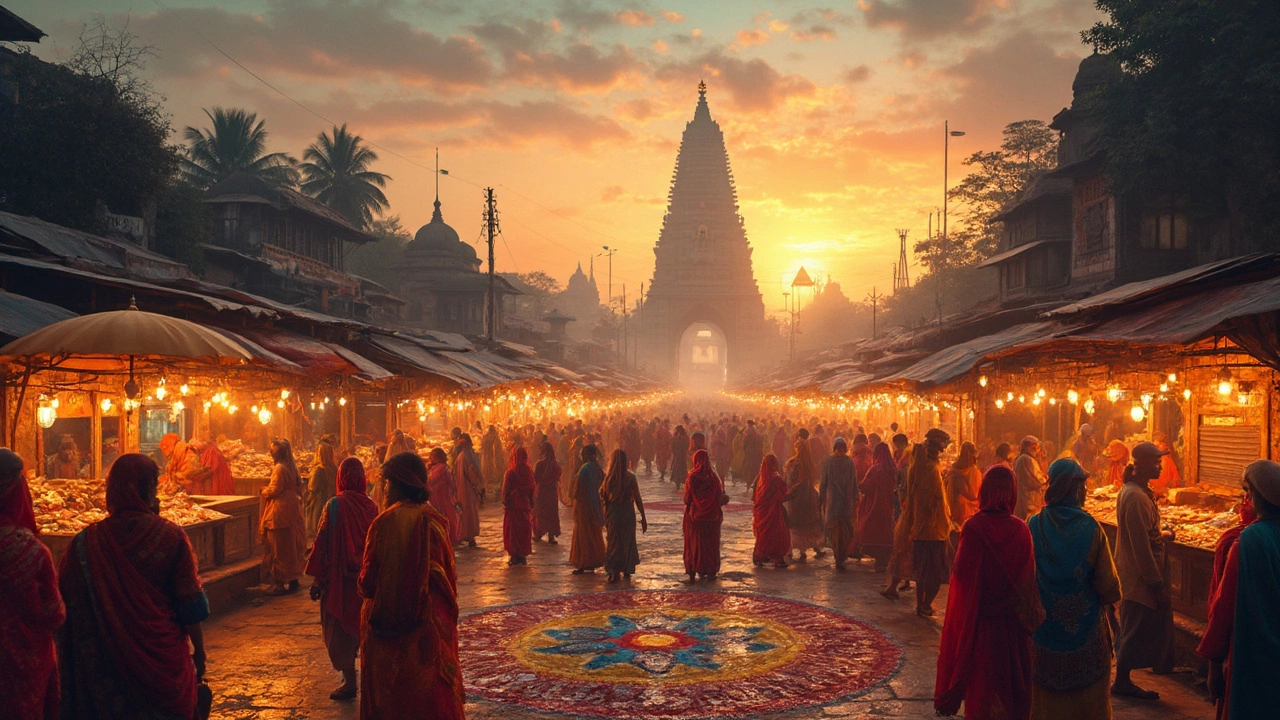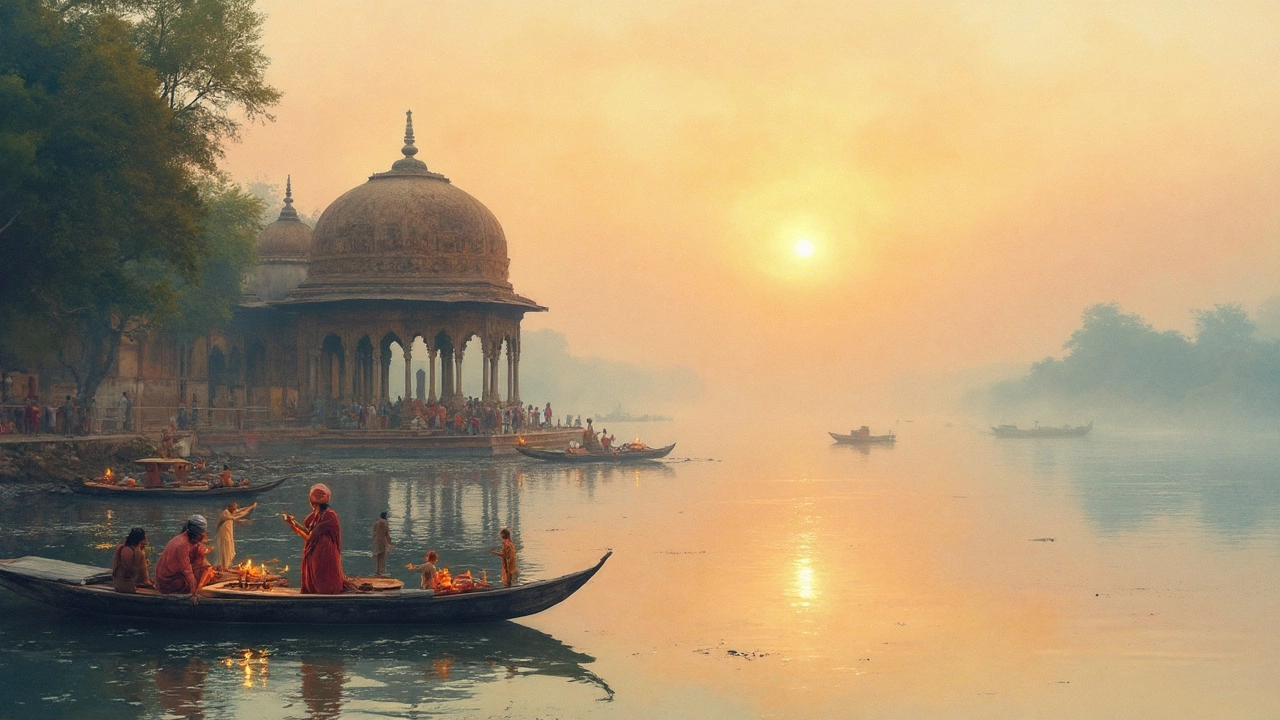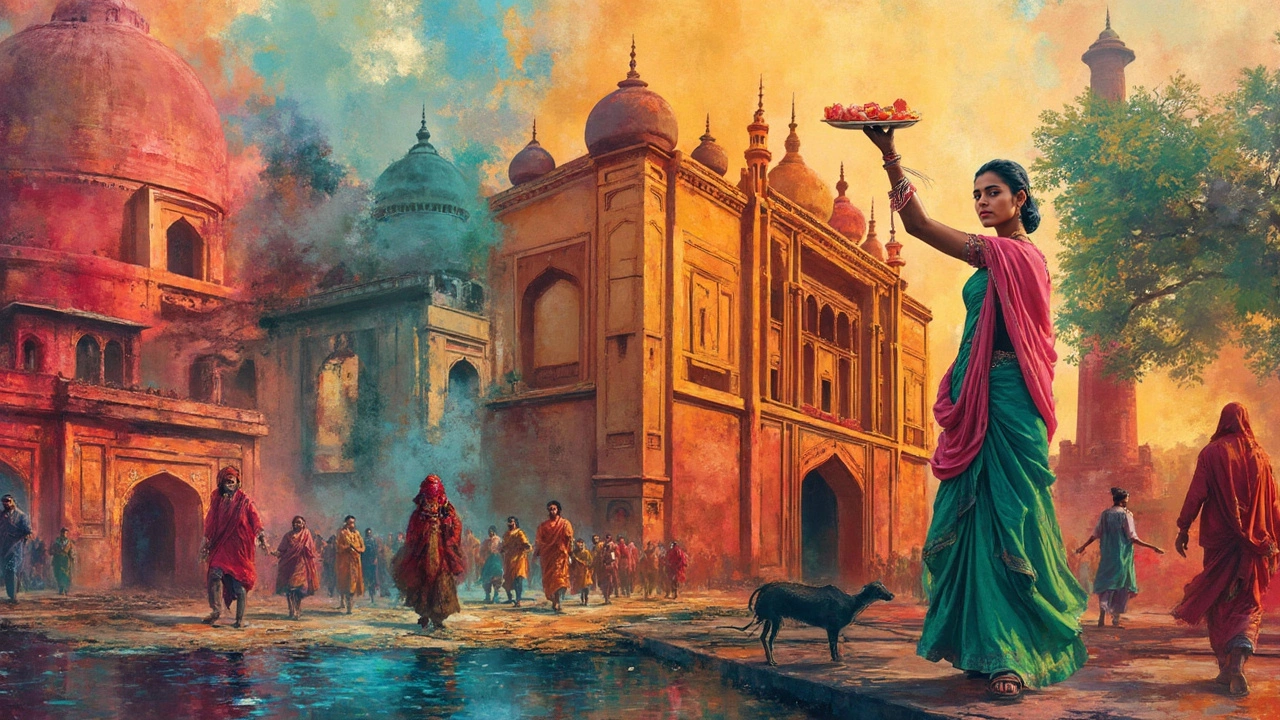Cultural Tourism India: Why Tourists Keep Coming Back
 Apr, 20 2025
Apr, 20 2025
If you’ve ever wondered what pulls millions of travelers to India each year, it’s not just the Taj Mahal or the yoga retreats. It’s the feeling of total sensory overload—the smell of spices, the colors in a street market, the sound of traffic mixed with temple bells. There’s nothing else quite like it.
People arrive expecting a standard vacation but leave with wild stories, new friendships, and a craving for chaat or mango lassi that never really goes away. Even big cities like Delhi and Mumbai have pockets where you’ll catch an unexpected festival or stumble into a centuries-old temple wedged between coffee shops.
The best part? No matter where you go, someone’s always willing to share travel tips, point you to their favorite chai stall, or drag you into a wedding just because you happen to be passing by. India’s culture isn’t behind museum glass—it’s in the chaos of traffic, the warmth of strangers, and the everyday surprises you never see coming. These are the reasons people come for the landmarks and stay for the culture.
- A Living Tapestry: India's Diversity Up Close
- Food, Festivals, and Friendly Faces
- Must-See Cultural Hotspots
- Insider Tips for First-Time Visitors
- Hidden Surprises and Quirky Finds
A Living Tapestry: India's Diversity Up Close
It’s wild how much cultural tourism India offers just because of the sheer variety packed into one country. India isn’t just one language, one look, or one kind of food. There are 22 official languages and around 2,000 distinct ethnic groups. You could take a train from Delhi to Chennai and feel like you’ve crossed a continent.
Ever noticed how the clothes change from state to state? In Rajasthan, bold turbans and colorful saris show off Rajput pride, while folks in Kerala stick to simple, white dhotis and mundus. Up north, you’ll find spicy, creamy curries loaded with butter and paneer. Swing over to the coastal south, and it’s rice, coconut, and lighter gravies everywhere.
Religions add another layer to the mix. India is home to Hinduism, Islam, Christianity, Sikhism, Buddhism, and Jainism—sometimes all in the same city. Walk through Varanasi and you might hear temple bells at sunrise, azan (the Muslim call to prayer) by noon, and church bells in the evening. It’s real and happens daily.
| Language | State/Region | Number of Speakers (Millions) |
|---|---|---|
| Hindi | North/Central | 600+ |
| Bengali | West Bengal, East | 90+ |
| Tamil | Tamil Nadu, South | 70+ |
| Marathi | Maharashtra, West | 80+ |
The fun part for travelers? No two places feel the same. You’ll get new smells, styles, and flavors from one town to the next. That means every trip messes with your expectations (in a good way). If you want to actually see how diverse Indian culture is, ditch the tourist trail for a bit and hop a local train—each new stop literally tells its own story.
Food, Festivals, and Friendly Faces
Forget any idea that Indian food is just about curry. The cultural tourism India scene thrives because every region has its own style and street food. In Delhi, you’ll find spicy chaat and butter chicken that locals swear is the city’s pride. Head down south to Kerala and you’re eating dosa with coconut chutney for breakfast. Mumbai’s vada pav costs less than a soda but packs way more flavor. Even McDonald’s in India has a masala twist on the menu. If you’re a food lover, exploring different states is basically a food tour—a real one, not a fancy tasting menu.
The calendar here is packed with celebrations. Diwali is the big one—nearly a billion people light candles and set off fireworks for days. Holi is like a giant paint fight. Travelers love it because you can join locals on the street, toss colored powder, and nobody minds you making a mess. If you’re around in late September, there’s Ganesh Chaturthi in Mumbai, where massive statues get carried through the city and everyone dances in the streets. The real trick: there’s always a festival going on somewhere in India, so check the calendar before booking a trip.
People are what make India stand out. Seriously, locals go out of their way to help visitors. Whether you’re looking lost in front of a metro map or trying to buy fruit from a market stall, there’s usually someone willing to step in. Sometimes you'll even end up as a special guest at a stranger’s wedding. It’s not a rare story—tourists often say it happens at least once. Language barriers can be tricky, but hand gestures and a few words of Hindi or the regional language go a long way.
Here’s a quick glance at just a few highlights travelers mention all the time:
- Trying street food in Chandni Chowk, Delhi
- Celebrating Holi with local families in Vrindavan
- Watching a traditional Kathakali show in Kerala
- Getting invited to a wedding or festival parade
- Snacking on samosas from a moving train
And yes, about 90% of travelers who visit for cultural tourism India say the social energy and friendly faces are what they remember most—way more than any postcard landmark.

Must-See Cultural Hotspots
You can’t really say you’ve experienced cultural tourism India without hitting a few places that show off the country’s heart and history. Here’s where most travelers end up making their best memories.
- Varanasi: This city is buzzing with life—and rituals—right on the Ganges River. At sunrise, locals and travelers gather along the ghats (steps to the river) to watch priests perform aarti (fire ceremonies). Hearing chanting mixed with splashes from the river is just something you won’t forget.
- Jaipur: Known as the Pink City, it’s famous for the Amber Fort and bustling bazaars. You’ll see people bartering for jewelry and riding elephants up the hill to the fort. There’s no shortage of color here—literally and culturally.
- Amritsar: Home to the Golden Temple, the spiritual center for Sikhs. Anyone can eat in the community kitchen, which serves up to 100,000 free meals a day. That’s not a typo. Everyone sits together, rich, poor, or foreigner. Even for India, that feels extra welcoming.
- Kolkata: Known for its colonial buildings, street art, and festivals. If you’re in town during Durga Puja, you’ll see the city turn into one big celebration, with parades and music on every block.
- Hampi: This might be the most relaxed ancient ruin site ever. Giant boulders, old temples, and chilled-out cafes along the river. Backpackers love staying longer than planned here.
Don’t forget, the Indian culture hits differently in each place. Even something as everyday as sipping chai feels unique depending on where you are.
According to Lonely Planet, “India is not a country you just see; it’s a country you feel—on your skin, in your lungs, through your taste buds, and in your soul.”
“India is, in every sense of the word, intoxicating.” – Lonely Planet
If you want a mix of sights, sounds, and jaw-dropping history, these destinations show why travelers think why tourists love India is a question that basically answers itself.
| Hotspot | Main Attraction | Best Time to Visit |
|---|---|---|
| Varanasi | Ganga Aarti, Ghats | October–March |
| Jaipur | Amber Fort, Bazaars | November–February |
| Amritsar | Golden Temple, Wagah Border Ceremony | October–March |
| Kolkata | Durga Puja, Colonial Landmarks | September–December |
| Hampi | Ancient Temples, Boulders | October–February |
Every one of these places offers something special you’ll want to brag about back home. Just pick a spot and let India do the rest.
Insider Tips for First-Time Visitors
Planning your first trip for some cultural tourism in India? There are a few things you’ll want to know before you land in the middle of all that action. India works differently from what most travelers are used to, and a little prep goes a long way.
First off, don’t be afraid of the crowds. Places like Delhi, Mumbai, and Jaipur can feel packed, but that’s normal—especially around big sights like the Red Fort or India Gate. If you get lost, just ask for help. People will often go out of their way to point you in the right direction or even take you there themselves.
Cash is still important in everyday transactions. While cards work in big stores and hotels, you’ll probably need rupees for rickshaw rides, street food, or small market purchases. ATMs are common, but it’s smart to carry smaller bills since shopkeepers often can’t break large notes.
Here’s a quick look at how far your money might go:
| Item | Average Cost (in INR) |
|---|---|
| Street Food Snack | ₹30-50 |
| Auto Rickshaw Ride (short distance) | ₹40-100 |
| Local SIM Card (with data) | ₹200-300 |
| Museum Entry | ₹250-600 (for foreigners) |
Watch what you eat and drink. Bottled water is the way to go, and try to eat cooked foods from places that look busy—locals flock to the best stalls. Hand sanitizer is your friend, especially when trying all those new flavors.
Getting around can seem wild at first. Trains are iconic and affordable, but you should book tickets in advance—especially for popular routes like Delhi to Agra (why tourists love India: the Taj Mahal never gets old). Tuk-tuks or ride-share apps like Ola and Uber work well in most cities.
Finally, dress modestly, especially in smaller towns and religious spots. Covering your shoulders and knees is usually enough. And always remove your shoes before entering temples or someone’s home—it’s a sign of respect.
If you remember these basics, you’ll focus less on logistics and more on the fun stuff—like discovering why tourists love India in the first place.

Hidden Surprises and Quirky Finds
One thing you learn fast with cultural tourism india is that surprises are everywhere—and usually, the best parts of the trip aren’t in any guidebook. Ever walked into an auto-rickshaw museum? There’s one tucked away in Gujarat, full of classic and custom tuk-tuks. Or, if you’re around Jodhpur, you’ll find the quirky “Om Banna” shrine, where locals worship a Royal Enfield motorcycle that’s said to bring good luck to travelers.
Let’s talk about the North East. Most tourists miss it, but places like Mawlynnong in Meghalaya are known as the cleanest villages in Asia. You can cross living root bridges—actual trees woven into footpaths by hand. In Kerala, you might catch a Theyyam performance, an intense folk dance where performers dress in wild, painted costumes you’d never spot on an Instagram hashtag unless you knew exactly where to look.
- Jaipur has hidden stepwells (called baoris or bawdis) that seem built for another world. Chand Baori, for example, is a maze of 3,500 steps and once showed up in Batman movies.
- In Varanasi, besides the famous ghats, there’s a small restaurant that’s run entirely by former street kids learning to cook and serve. It changes lives and serves the best chai around.
- Leh’s Magnetic Hill looks like it’s pulling cars uphill—locals will bet you it’s magic, while scientists say it’s just an optical illusion. Either way, you’ll want a picture for proof.
Plenty of spots put their own spin on Indian culture. Down in Tamil Nadu, you might join locals for a Pongal celebration, where they cook rice in open-air pots until it boils over for luck. In the monsoon season, Maharashtra’s villages set up tottering bamboo swings and organize unique bullock cart races.
If you’re a numbers kind of person, check out just how diverse these finds are:
| Region | Quirky Experience | Estimated Annual Visitors |
|---|---|---|
| Gujarat | Auto Rickshaw Museum | 10,000 |
| Meghalaya | Living Root Bridges | 45,000 |
| Rajasthan | Chand Baori Stepwell | 60,000 |
| Leh | Magnetic Hill | 75,000 |
Every region has its thing—offbeat places that tell you what locals love and how they celebrate. Chasing these hidden gems? That’s where you really get why tourists love india.